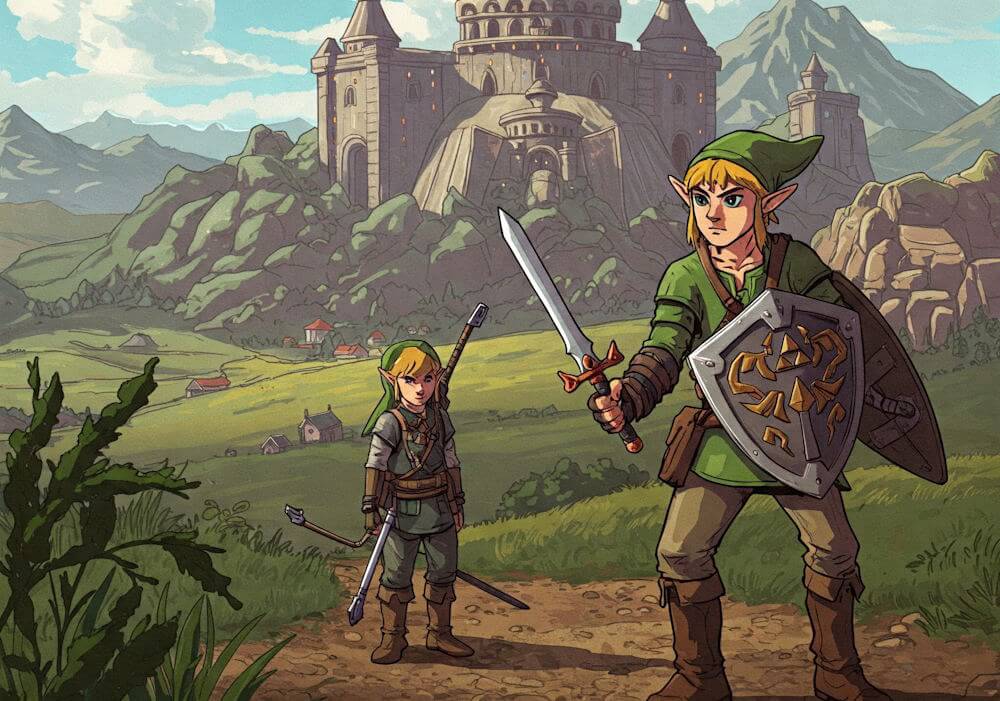Open-world gaming has transformed the landscape of the gaming industry, offering players an unparalleled experience characterized by vast, immersive environments that encourage exploration and interaction. Unlike linear game designs, which guide players along a predetermined path with limited choices, open-world titles provide a sandbox-like approach where players can navigate expansive worlds at their own pace. This freedom allows for a variety of gameplay styles, catering to different preferences and offering a personalized gaming experience.
The core characteristics of open-world games include non-linear quests, dynamic environments, and a focus on player agency. Players are often given multiple paths to complete objectives, allowing for diverse playthroughs and countless possibilities. This design encourages exploration, with hidden secrets, side missions, and varied landscapes rewarding those who venture off the beaten path. The ability to roam through richly crafted worlds fosters a sense of immersion, as players can engage with the environment, interact with non-playable characters, and unravel intricate narratives that evolve through their choices.
Furthermore, storytelling in open-world games frequently adapts to the player’s decisions, enhancing the emotional connection to the game. Unlike traditional linear games where the plot progresses through scripted events, open-world titles often feature branching storylines that react to player actions, creating a unique narrative experience for each individual. This level of depth not only enriches the gameplay but also elevates the status of video games as a medium for storytelling.
As we delve deeper into the evolution of open-world design, it is essential to examine iconic titles that have shaped the genre. By understanding their impact, we gain insight into how open-world gaming has progressed and the innovative approaches employed by developers to create captivating gaming experiences.
The Origins: The Legend of Zelda
Released in 1986 by Nintendo, ‘The Legend of Zelda’ marked a significant turning point in video game design, essentially laying the groundwork for open-world gaming as we recognize it today. This groundbreaking title introduced players to a vast, interconnected world ripe for exploration, encouraging a level of freedom seldom seen in earlier games. The use of a non-linear approach allowed players to traverse the mythical land of Hyrule at their own pace, a concept that has become a hallmark of open-world gameplay.
One of the defining features of ‘The Legend of Zelda’ was its emphasis on exploration. Unlike many contemporaneous titles that guided players through linear levels, this game offered a sprawling environment where discovery was a core mechanic. Players were not merely progressing from one stage to the next; they were encouraged to delve into hidden caves, uncover secrets, and piece together puzzles. This engagement fostered a sense of adventure that laid the seed for future open-world titles, making exploration an essential aspect of the gaming experience.
In addition to its exploration mechanics, the game incorporated puzzle-solving elements deeply intertwined with the gameplay. Players had to acquire various items to progress, revealing pathways and unlocking new areas in a manner that prompted critical thinking. This intricate layer of gameplay not only enhanced the player’s immersion but also set a standard for how complex game narratives could be woven into the mechanics of exploration and puzzle-solving.
The Legend of Zelda’s non-linear design philosophy and its innovative mechanics paved the way for subsequent open-world games, influencing iconic titles like ‘Grand Theft Auto’ and many others. Its rich narrative and captivating gameplay experience demonstrate the lasting impact of this pioneering work in the evolution of open-world design.
The Rise of 3D Worlds: Super Mario 64 and Beyond
The transition from 2D to 3D environments marked a significant milestone in the history of video games, redefining how players engage with virtual worlds. At the forefront of this evolution was ‘Super Mario 64,’ released in 1996 by Nintendo, which showcased the potential of 3D graphics in a manner that resonated with players and developers alike. This game was not just a technological showcase; it fundamentally influenced the framework of open-world design by allowing players to explore expansive environments with unprecedented freedom.
In ‘Super Mario 64,’ players navigated through a series of vibrant worlds filled with diverse challenges and obstacles, all rendered in a 3D space that encouraged exploration and interaction. Unlike traditional 2D platformers, where movement was typically constrained to linear paths, this pioneering title introduced an open-ended gameplay approach. Players could roam within vast arenas, choosing how to tackle objectives in their own unique ways. This freedom cultivated a sense of agency seldom felt in previous gaming experiences.
The mechanics established in ‘Super Mario 64’ had far-reaching implications. By integrating platforming elements within a 3D landscape, it offered developers a blueprint for creating similar experiences. The game’s emphasis on traversable environments paved the way for further innovations in game design, with many subsequent titles drawing inspiration from its approach. Notably, several open-world games that followed have echoed its design philosophies, blending exploration, platforming, and navigational freedom to create immersive worlds for players.
Thus, the advent of 3D worlds, exemplified by ‘Super Mario 64’, not only showcased the potential of new technology but also laid the groundwork for the expansive open-world designs that emerged in the late 1990s and early 2000s, influencing iconic franchises from ‘The Legend of Zelda’ to ‘Grand Theft Auto’.
The Birth of Modern Open Worlds: Grand Theft Auto III
The release of Grand Theft Auto III in 2001 marked a pivotal moment in the evolution of open-world game design. Set in the fictional Liberty City, the game provided players with a sprawling urban environment teeming with opportunities for exploration, interaction, and chaos. This sandbox approach allowed for a narrative experience that was both immersive and engaging, a significant shift from linear storytelling prevalent in prior games.
One of the noteworthy aspects of GTA III was its emphasis on character interaction and player agency. Players could choose how to engage with the game’s world, whether by following the main storyline or indulging in side missions encompassing car thefts, bank heists, and other illicit activities. This freedom had never been presented in such depth, as players could traverse the city freely, encounter random events, and make choices that influenced their gameplay experience. The degree of agency offered facilitated a sense of ownership over one’s progression, allowing individual playstyles to flourish.
The balance between scripted events and player agency in Grand Theft Auto III contributed significantly to its lasting popularity. The game features rich narrative arcs delivered through meticulously crafted mission structures, yet it simultaneously empowers players to deviate from these paths at their whim. This blend of structured storytelling with an open-world format fostered a dynamic experience, attracting players seeking both a compelling narrative and the freedom to explore at their own pace. Furthermore, the game set a precedent for future titles in the genre, encouraging subsequent developers to adopt and adapt its innovative design principles.
Diverse Experiences: The Impact of RPGs on Open-World Design
Role-playing games (RPGs) have significantly shaped the landscape of open-world design, delivering immersive experiences that blend expansive environments with rich storytelling. Among the most notable examples is The Elder Scrolls V: Skyrim, which epitomizes the genre’s impact by creating a lush, detailed world filled with quests, characters, and lore. The game’s open world encourages exploration and interaction, allowing players to engage deeply with diverse narratives shaped by their choices.
In Skyrim, players traverse the vast terrain of Tamriel, encountering unique factions, mythical creatures, and various quests that contribute to a sense of immersion. The integration of these complex systems allows for a personalized adventure where each decision leads to different outcomes. This narrative depth, combined with environmental intricacies, enhances the player’s connection to the world, a hallmark of effective open-world design.
Similarly, The Witcher 3: Wild Hunt stands as a testament to the RPG’s influence on open-world game mechanics. With its narrative-driven approach and well-developed characters, it provides an engaging experience where player choices wield significant weight. The game features a meticulously crafted world teeming with side quests that not only enrich the lore but also enhance the players’ engagement with the storyline. The moral ambiguity presented in decisions makes each interaction meaningful, thus contributing to a more profound emotional response from players.
The emphasis on narrative depth and interactivity in these RPGs has set benchmarks for other genres, encouraging game developers to adopt similar design principles. As a result, the influence of RPGs on open-world design continues to evolve, paving the way for future titles that promise diverse experiences and complex storytelling in expansive terrains. These innovations mark a turning point for player engagement, shaping the trajectory of open-world gaming for years to come.
Emergence of New Genres: Open-World Survival and Sandbox Games
The evolution of open-world design has significantly expanded the landscape of gaming, particularly with the emergence of survival and sandbox genres. Titles such as Minecraft and ARK: Survival Evolved have pioneered new gameplay mechanics that encourage exploration, creativity, and resource management within expansive environments. These games provide players with a unique blend of freedom and challenge, which sets them apart from more linear or guided experiences found in traditional games.
Minecraft revolutionized the gaming world by introducing a block-based environment where players could manipulate the terrain and craft tools, buildings, and even entire societies. This open-world construction mechanic fosters creativity, allowing players to express themselves through custom-built structures and gameplay styles. The inception of survival elements, such as health management and resource gathering, adds depth to the open-world experience, pushing players to adapt and strategize in real time. This balance of creativity with survival aspects marks a significant shift in expectations, as players now seek not just to explore, but to create and thrive within their environments.
Similarly, ARK: Survival Evolved incorporates open-world survival mechanics by placing players in a prehistoric setting teeming with dinosaurs and other players. In this vast world, players are tasked with gathering resources to build shelters, craft weapons, and tame creatures. The multiplayer aspect of ARK also promotes community interaction, allowing for cooperative gameplay, where players can band together or compete against one another. Such dynamics foster a thriving ecosystem within the game, leading to unique player-generated stories and experiences.
The rise of these genres showcases the versatility of open-world design, highlighting how players’ expectations have evolved to encompass not only exploration but also the ability to create, survive, and collaborate within boundless virtual landscapes. As the industry continues to innovate, the foundations laid by games like Minecraft and ARK suggest that the future of open-world gaming will only become richer and more diverse.
The Role of Technology: Graphical Advancements in Open-World Games
In the realm of open-world gaming, the evolution of technology has played a pivotal role in shaping the immersive experiences players enjoy today. From the classic pixelated landscapes of early titles to the stunningly detailed environments seen in contemporary games, advancements in graphics and processing capabilities have transformed how developers craft expansive game worlds. The introduction of high-definition graphics, advanced rendering techniques, and dynamic lighting effects has made virtual landscapes more lifelike than ever before.
One significant development influencing open-world design is the improvement in physics engines. These advanced systems simulate real-world behaviors, allowing in-game objects to interact in believable ways. For instance, in games like Red Dead Redemption 2, players can see realistic animal movements, weather effects, and environmental interactions that create a rich tapestry of realism. Physics engines also enhance gameplay by providing players with new mechanics, such as destructible environments and natural interactions, which encourage exploration and creativity.
Moreover, artificial intelligence (AI) contributions cannot be overstated. As AI algorithms have evolved, developers have been able to create more sophisticated non-player characters (NPCs) that enhance gameplay and storytelling. NPCs in open-world titles now exhibit complex behaviors, engaging players through meaningful interactions and dynamic decision-making processes. This level of engagement further deepens player immersion, as the game world feels alive with characters that respond realistically to the player’s actions.
As technologies continue to advance, the potential for even more intricate open-world designs expands. The ongoing development of virtual reality and augmented reality technologies is poised to redefine player interactions, allowing for even greater immersion and engagement. The integration of these innovations ensures that the evolution of open-world gaming will persist, continually enhancing the player experience through more breathtaking graphics, realistic physics, and intelligent AI systems.
The Future of Open-World Design: Trends and Innovations
As the landscape of video games continues to evolve, the future of open-world design is poised for significant transformation, driven by emerging technologies such as virtual reality (VR) and artificial intelligence (AI). These innovations stand to enrich player experiences, offering greater interactivity and depth in storytelling. The integration of VR technology allows players to immerse themselves in vast digital environments, creating a sense of presence previously unattainable in traditional gaming formats. With VR, players could virtually step into expansive worlds, interacting not just with the environment but also with characters in a more impactful way.
One of the key trends expected to shape open-world design is the advancement of AI, which can introduce dynamic elements and enhance player agency. AI can facilitate realistic NPC (non-player character) behaviors, allowing them to react intelligently based on player actions. This capability could lead to environments that feel alive, where every decision influences the world in meaningful ways. Moreover, AI can adapt the narrative and gameplay mechanics on-the-fly, tailoring experiences specific to individual players, thus fostering a more personal connection to the game.
Additionally, environmental storytelling is likely to become a more prominent feature in open-world games. Developers are expected to leverage data-driven design to create worlds that tell stories through their landscapes and ecosystems. As players explore, they may uncover lore and history embedded in the environment, enriching their journey and providing context to their actions. The convergence of these technologies suggests a future where open-world games are not merely expansive maps to traverse but intricate ecosystems with rich narratives and interactivity, making each player’s adventure unique. The fusion of VR and AI heralds a new era for open-world gaming, encouraging innovation and creativity in how stories are told and experienced.
Conclusion: The Lasting Legacy of Open-World Games
The evolution of open-world design has profoundly shaped the gaming landscape, beginning with early pioneers like “The Legend of Zelda” and extending to contemporary titles such as “Grand Theft Auto” and various others. These games have created immersive environments where players can explore vast virtual worlds at their own pace, marking a significant shift from linear gameplay structures. This flexibility not only enhances player engagement but also fosters a sense of agency, allowing individuals to craft their unique gaming experiences.
From their inception, open-world games have held a mirror to cultural narratives, reflecting society’s values, struggles, and aspirations. Titles spanning from fantasy realms to modern-day urban settings have allowed players to navigate narratives that resonate on a personal level. As a result, the genre has gained a substantial following, influencing both popular culture and gaming development practices. Developers have been inspired to innovate continuously, pushing the boundaries of technology and storytelling to deliver increasingly rich narratives and dynamic environments.
The impact of open-world games extends beyond mere entertainment; they have become platforms for social interaction and community building. Players often share their adventures, challenges, and creative approaches, contributing to an ongoing dialogue within the gaming community. This interconnectedness enhances the experience and solidifies the significance of open-world design in gaming history.
Looking toward the future, open-world games seem poised for further evolution. Emerging technologies such as virtual reality, augmented reality, and advancements in artificial intelligence present exciting opportunities for developers to create even more engaging and expansive worlds. As these innovations unfold, it is evident that the legacy of open-world games will continue to resonate, providing profound experiences that captivate players for years to come.




